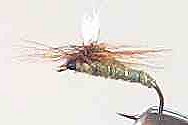The Greenwell's Glory Parachute Dry Fly
The Parachute dry fly version of Greenwell's Dry Fly pattern is an ideal imitation for mayfly duns and spinners, buzzer insects, pond and lake olives. It was devised in 1854 by Canon Greenwell and James Wright to tempt large brown trout on Scotland's River Tweed.

PARACHUTE EMERGER DRY FLIES. Hook size 12 14 16 18 20 24 - $US each
Pond & Lake Olive Insects (Cloeon dipterum) live in slow moving rivers, ponds and lakes and this fly is a good representation for them. The Canon Greenwell picked up a natural fly off the water and took it to James Wright a fly tyre who lived in Sprouston, Roxburghshire. It was James Wright who copied the natural insect. A local schoolmaster called Mr Brown named the pattern, Greenwell's Glory. For the stillwater fly fisher lake olives are an important insect to have artificial imative flies. It emerges during the day throughout the summer. The female hatches the lava within her body and then drops to the water in the evening or during the night. She releases them on to the water, where they then swim to the bottom. It is not unusual to see the water littered with dead or dying Pond and Lake olive spinners in the early morning. Watch the trout rise for them two to three hours after dawn. Treat with floatant and fish on the surface. Leave the fly to drift with the current. Occasionally scoot it gently over short distances.
The term parachute fly is given to flies in which the hackle is tied round a projection affixed to the top of the hook shank near the eye so that the hackle lies horizontally across the hook which it covers in the manner of an open umbrella. The weight of the hook underneath the circular hackle balances the fly which falls lightly on the water parachute fashion. Various patterns are tied in the parachute style and a Scottish tackle firm was the first to commercially market these flies a long time ago. It is not certain who invented them but an American called William Brush of Detroit applied for an American patent for the idea in 1931 and it was granted in 1934. The patent related to the projection on the hook and not the fly itself.
The traditional way of dressing dry flies with upright wings and hackles that make the fly stand high on the water's surface may be very pleasing but it is not necessarily the best design for catching fish in some anglers opinions. The parachute dry fly style of dressing allows the fly to sit well down in or on the surface film, mimicking either an emerging mayfly dun filling its wings, a spent spinner, stillborn, floating nymph or a crippled drowning fly trapped in the surface film. They can be dramatically more effective at getting takes. Some traditionalist will not use them but I find them very effective and easy to cast correctly. I have found them more suited to still water fishing as once a ripple or two has broken over them they become waterlogged. The softer landing, the delicate presentation is one of this patterns principle benefits. The parachute effect of the hackle slows down the descent. It does not spook the fish as much as a normal dry fly. They are one of my favorite lake flies. When the trout are rising and taking food with a gentle sipping action these are the flies to use.
When the mayflies have stopped emerging and the surface action has died down. The fishing is not over if you know where to look. Go for a walk down the riverbank and look for bankside eddies, areas of slow slack pockets of water near faster moving water. A lot of mayflies do not successfully emerge during the hatch. They are referred to as cripples or stillborn. Others are flipped over, capsized in choppy water. They seem to collect in these eddies. You will find trout rising to them long after the original hatch has finished. Cast a Parachute into these pockets and let it drift. It is a great way to extend your surface fishing time.
Fly Fishing books

